The face of climate change along Turkana’s Turkwel river

In this series of blogposts researchers from the project Governing Adaptation Finance for Transformation (GAP) share their insights on different dynamics of climate finance, with a specific focus on Kenya and Tanzania.
The Turkwel River in northern Kenya’s Turkana County flows from Mount Elgon on the border of Kenya and Uganda to Lake Turkana in the north-eastern part of Kenya. The name of the river means “the riv-er that resists the desert” but during the past years, the justification of the name could be highly questioned. The long rains are late and most other rivers have been completely dry for months and in some places, it has not rained for four years. The Turkwell river has therefore shrinked to a dry and muddy riverbed, to the detriment of all who depend on water for their livelihood around the river.
This place illustrates one example of climate change showing itself as a threat multiplier in these dry-lands. Even when the rain comes, much evaporates immediately and never gets to percolate and nur-ture the soil. In other instances, the rains fall as concentrated downpours in shorter and more unpre-dictable periods than it used to, and the force of the sudden rains turns into flash floods. This makes it challenging even for those who try to adapt to the conditions by collecting water for drip irrigated farming. Flash floods wash away the roads and water systems and make wells collapse.
For the cattle and goats, grass is impossible to come by and the greens that are still available are ei-ther the thorny acacia or the invasive prosopis juliflora – a fast-growing bush-like scrub that forces the existing vegetation to disperse even more from these drylands. The livestock feeding on the prosopis lose their teeth and die, and the stems are too thin to use for charcoal. As an invasive plant, the prosopis has no natural enemies in the ecosystem and spreads uncontrollably in large parts of East Africa.
The temperatures here are already reaching 40 Co during the hottest months of the year, so with cli-mate change projections it may only take a couple of decades with our current course of action be-fore temperature increases turns Turkana wholly unfit for human presence. This begs the uncomforta-ble question of how long we should invest in adaptation before accepting migration as the only viable alternative.
Caught in institutional loopholes
If we are to make an attempt at adaptation, there are however much room for improvement. The Turkana communities depending on the river are agropastoralists who move their livestock around to find water and grazing – a practice perfectly fit for these dry conditions. But farming practices are also attempted although the dry conditions and the missing rain makes irrigation necessary. 5 years ago, Kenya’s central government commenced construction of an irrigation canal that could lead the water from the river to the irrigated fields. But not long after it was complete, the river shifted course and the project stalled entirely. The farmers are now unable to use the irrigation systems and their fields become unmanageable. Since it was the central government who built the irrigation canal, the area is considered as a territory for the state to intervene on adaptation matters. As such institutional terri-torial norms prevent the county government from intervening.
Besides speaking to how governance aspects can impede adaptive efforts, this example also points to a more general, historical tendency in which Turkana as a geographical county and ethnic group, has been subject to marginalization and systematic social exclusion by Kenyan governments. This in terms of political deprioritizing, including economic support, development opportunities, and protection from cross-border violence.
In addition, internally, among the several local communities in Turkana, the atmosphere is fraught and charged. When resources are sparse, local institutional power struggles easily arise. Natural resources-based conflicts between communities are increasing across Kenya due to climate change induced re-source scarcity and Turkana County with its semi-arid and arid landscapes is no exception.
Money changes hands
Unmet expectations to the service delivery of different institutions also create frustration and ten-sion. People are discouraged and disappointed with the weak governance, the inadequate institution-al infrastructure, and the implementation of adaptation efforts. They see little of the millions of funds pledged by governments across the world to be directed towards adaptation in the most affected are-as. Many times they have been asked to gather and welcome a government official or representative from a donor, who has told them of a new large programme with an exorbitant budget to spent, only to realise years later that what was left for them in the end only amounted to the digging of a couple of boreholes. Every time an amount of money changes hands, a share is left behind to cover admin-istration and control. After several hands have been involved, the figure originally pledged has dimin-ished significantly. While some of this is necessary to ensure proper coordination and documentation, other factors weigh in as well. Some funds pledged comes with strings attached or become subject to someone’s political purpose, causing funds to be channelled into other projects or areas than what it was intended or needed for. So the key question is: How do we ensure that as large a share as possi-ble of these funds earmarked for the most vulnerable regions actually reaches those who need it the most?
What about effective institutional infrastructure?
One response is to look more carefully into the flow of funds and institutional relationships of climate finance. Key questions must also explore how public sector efforts can be supplemented by other actors, what role the process of political decentralization plays and how the implementation of new institutional infrastructure relating to climate change finance and distribution of financial resources functions.
Since Kenya’s devolution reform in 2010, local and regional institutional structures have been put in place to accommodate more power sharing and local representation. Devolution provides means to channel climate finance to sub-national levels. If it works properly, it can strengthen and recognize the local priorities and capacities and be decisive for the effectiveness of the climate change adapta-tion projects. The reform may however have brought forth a range of new challenges, including the decentralization of power conflicts that were previously centralized, unclear institutional jurisdictions and overlap, and more institutional hands to pass through to get to local communities in risk areas. In addition to devolution, Kenya has implemented a range of policies for targeting climate change. Of particular importance is the set up of County Climate Change Funds, CCCF, with the goal of more ef-fective and enhanced mobilization and utilization of climate financing. The CCCF mechanism offers a robust approach to local climate actions and transparent structures, which have the potential to help local communities build climate resilience. In Turkana County, the mechanism is however still in the process of being implemented.
The project Governing Adaptation Finance for Transformation (GAP) is investigating all this with an approach towards better understanding and a more thorough insight into the relationship between climate finance adaptation, devolution, governance, and institutions.
Is there a business case for the private sector?
In addition to the public efforts, could there be a business case for the private sector to go into cli-mate change adaptation in areas like Turkana? Should the government and local communities, to a greater degree, try to combine the climate finance adaptation projects with private companies and investments in order to successfully secure and complete effective projects?
The advantages of allowing the private sector greater opportunities for development in climate fi-nance could be increased efficiency and innovation, spanning from the responsibility to the share-holders and the bottom line. The access to capital is larger and faster compared to the public sector, which could enable more long-lived - adaptation projects. Could a brewery for instance see a possibil-ity to reestablish a functioning irrigation canal and set up an irrigation system that would enable the communities along the river to produce sorghum, which the brewery in turn would buy and use for beer production?
There are also potential disadvantages of private sector involvement. For instance, could benefit and profit motives lead to a decreased focus on the negative social and environmental impacts? Could it lead to a lack of transparency? And could the willingness to take risks generate a greater chance of failure?
The future solutions could be many, and they involve several institutions, actors and interactions which all are different from area to area, from community to community and from person to person.
DIIS Experts



